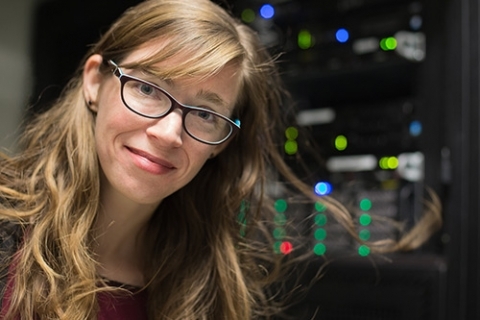A proposal to conduct high-performance computing across science and engineering disciplines has won UC Merced and Professor Christine Isborn a research computing cluster that will be used for a variety of projects across campus.

UC Merced professor Christine Isborn
Each year, Silicon Mechanics, a Washington-based provider of servers, storage and high-performance computing technologies, gives two such grants to campuses, nonprofits and federal labs chosen from across North America. Each winner gets a complete high-performance computing cluster worth about $100,000.
Isborn, a computational chemist with the School of Natural Sciences, outlined a need for computing equipment that will “empower our research objectives and give our students the tools they need to succeed in today’s technological environment” in her proposal.
“This award will greatly increase our computing capabilities,” she said. “With it, we plan to train students and postdoctoral scholars in our research areas, and increase our understanding of the physical world through modeling and simulation of complex phenomena.”
The cluster, which features graphics processing units like the ones used for video games, will permit researchers to use parallel processing to solve enormously complex problems that would take weeks on regular computers.
With it, researchers can develop models that accurately reflect physics and chemistry across length scales (from atoms to proteins and fluids) and time scales (from femtoseconds to minutes). Isborn said this work will yield fundamental insights into molecular interactions and pave the way for the next generation of modeling capabilities.
“This group of applied mathematicians, biologists, chemists, physicists and engineers is applying and developing groundbreaking techniques to understand molecular interactions and dynamics in complex environments,” Isborn said.
Other professors who are part of the proposal — Ashlie Martini, Ajay Gopinathan, Karin Leiderman, Suzanne Sindi, Hrant Hratchian and Michael Colvin — will use the cluster for projects including examining protein misfolding, prion diseases such as Mad Cow, an atomic-scale understanding of friction, bacterial cell division, fluid dynamics and more. The researchers will gain knowledge for applications ranging from engineering to medical treatments.
The cluster should arrive in the next few weeks, and will be housed in the Science and Engineering Building 1. It will be linked with the new visualization lab in the new Classroom and Office Building 2, so researchers will be able to get even greater visual understanding of their subjects.
Isborn said one of the most important parts of the grant is the opportunity it provides for student researchers.
“We want to involve students at all levels of the research training process,” she said. “This computing cluster is going to give them invaluable hands-on training.”



